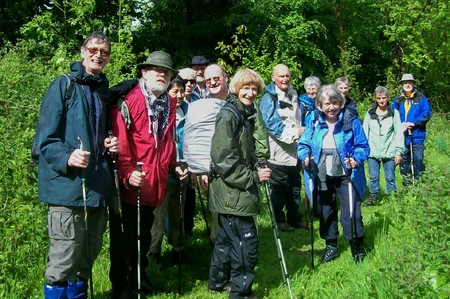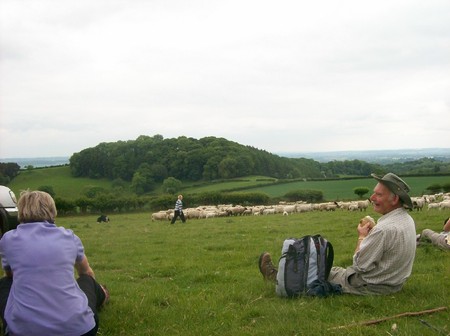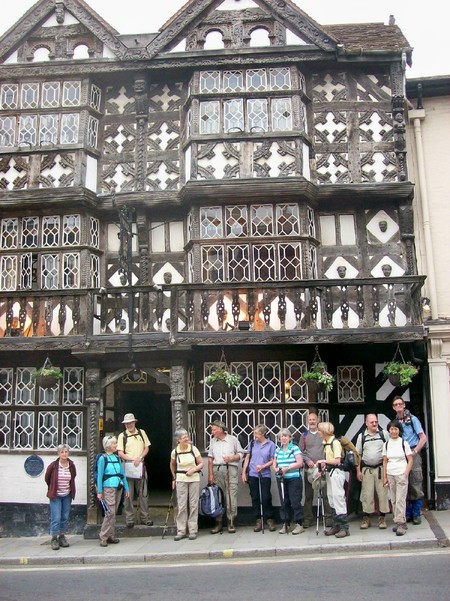- From the Chairman
- Slipping on banana skins...
- The Mortimer Trail May 2010
- Footpath Diversions and Other Matters
- The Walks Leader is your friend
- Oxford Transport Plan
- Residential visit to Longmynd, Church Stretton, Shropshire 2010
- Annual Skittles Evening 2001 - 2010
- Obituary: Anneke Siertsema 1938 - 2010
- Walking in a Winter Wonderland
- A Weekend in Lancashire, August 2009
- OFS Donation to the Chiltern Society Donate a Gate scheme
- Footpaths and Railway Lines
- Committee Members
The Mortimer Trail May 2010
Came a rainy, windy morning on a Saturday in late May as fourteen enthusiastic OFS members turned up at the Wheely Wonderful Cycling base at a farm near Ludlow. Seeing racks of mountain bikes, we wondered if we were expected to pedal push our way up and down the steep inclines all around us but fortunately not − minibuses took us to our starting place in the little town of Kington in Herefordshire near the Welsh border and we set off for our first 6 miles of the Mortimer Trail. From then on we went back and forth across various county lines and bits of England or Wales in a most intriguing and apparently haphazard way.
The Trail is a new 31 mile walking route along a succession of ridges and deep dips and we achieved it in three days, with two overnight stops at the historic Radnorshire Arms Hotel in Presteigne ending on the third day at the famous Feathers Hotel in Ludlow.
 Photo: Jane Jackson
Photo: Jane Jackson
Our first afternoon's section started in sun as we walked up and away from Kington over farm land, crossing a rather muddy Offa's Dyke bank and on through fields and a wooded area under pine trees to a lovely narrow walk edging along a beech wood with distant views on one side and a steep drop into the trees beneath on the other. Orchids were seen nearby. Large nettles too − another fortnight and they would be lush and really vicious, we thought. There were more woods and open farmland and then a long track down to the small rather handsome village of Titley where our minibuses were waiting to take us to Presteigne and the Radnorshire Arms a half timbered building dating to the Elizabethan period.
We wondered whether the ghosts would be walking at night through the oak-panelled rooms, the underground tunnels and the priest's hole. However, the hotel has been very well modernised and upgraded, we had a warm and welcoming reception, the food was good and none of us complained of creaking floors, spectral sights or candles suddenly blown out.
On then, back to Titley to start our second day which was a mixture of sun and clouds giving us a beautiful and very varied 12 miles walk, up and down, hills and valleys sweeping away on either side, well kept fields, forests and bluebell woods. We went past Wapley Hill Fort and along paths lined by tall pines to a ridge overlooking the valley of the Lugg river, down and steeply up again, on and past tiny Byton church and the Sunday morning service, more woods and a forest road to Covenhope Farm. It was a long time since our elevenses so we had a good picnic break in the farmer's field when suddenly a great whoosh of galloping sheep came thundering by. The farmer explained to us that he and his son and the dogs were going to sort out some sheep to take to market and then all was quiet again.
 Photo: Jane Jackson
Photo: Jane Jackson
The last section of Sunday's walk consisted of four miles along the River Lugg, an SSSI with otters, crayfish and spawning salmon (none spotted by us however). It was beautiful walking through Sned Wood and beside the gorge, passing an old Victorian water mill to end at the Riverside Inn at Aymestrey, just in time to buy our drinks before afternoon closing time and enjoy them by the tranquil river and ancient bridge. Back we went in the minibuses to the hotel and had a very pleasant dinner and get-together after an excellent day's walk.
We returned again next morning to Aymestrey on May Bank Holiday for a demanding but very attractive and varied walk of about 13 miles to Ludlow. We climbed up and up across woods and fields through forested areas of pines and oaks.There were great views over to the Black Mountains, the Radnor Hills and towards Long Mynd and Montgomery away to the north. We went near Croft Castle which has been the home of the Croft family pretty well continuously since the days of Edward the Confessor, but it was closed to visitors that day. If we had had more time here we would have looked around the National Trust's Croft Ambrey Iron Age hill fort which has a fabulous position above the valleys of the Lugg and the Teme; from the top of the fort it is possible to see 14 counties. Another day perhaps.
On we went along forest roads and common land with the Malverns and BBC transmitter aerials in the distance, finally reaching the extensive ancient Mortimer Forest. Here and there were large open grassy areas with lovely views across the forest below towards the Malvern Hills and Ludlow, which we finally reached by a pretty woodland trail, fetching up on the great bridge with the castle walls above. A gentle stroll through the medieval streets of 'the most beautiful small town in England' brought us to the famous halftimbered Feathers Hotel and the end of our journey.
 Photo: Jane Jackson
Photo: Jane Jackson
Three of us returned home while others were able to stay one night at the Feathers. All had enjoyed a wonderful walking holiday in excellent company and we were extremely well served by our leaders: Elizabeth Adams (who organized the trip), John and June Henville and Kay and Chris Dartnell of Wheely Wonderful Cycling.
